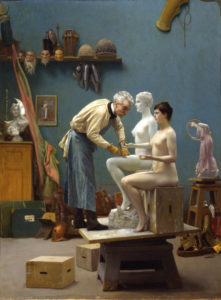WRITTEN BY HEATHER STEWART, MARKETING INTERN

Jean-Léon Gérôme, (French, 1824 – 1904), ‘Working in Marble’ or ‘The Artist Sculpting Tanagra’, 1890, oil on canvas, 19 7/8 x 15 9/16 in., Dahesh Museum of Art, New York 1995.104
Academic Splendor: Nineteenth-Century Masterworks from the Dahesh Museum of Art will open January 27 at the Cummer Museum. The Dahesh Museum of Art is the only institution in the United States that is devoted to collecting, exhibiting, and interpreting works by European and American academically trained artists of the 19th and early 20th centuries.
What does the term “academic” mean when referring to art? It is used to describe those artists who were formally trained and educated in academies or private ateliers. It encourages not only a certain style and technique, but also knowledge of classical, religious, allegorical, and mythological subjects. Artists were also expected to maintain the principles of ideal beauty displayed in Classical and Renaissance art.
In the 19th century, Paris was the center of academic art, and home of the Académie des Beaux-Arts (Academy of Fine Arts), which oversaw the premier art school — the École des Beaux-Arts. The Academy also ran the official exhibitions, called the Salon, where artists displayed their works. By following the Academy’s path, hopeful artists gained entry into a world of fame, public and private commissions, and an opportunity to join an elite circle. The academic movement was strongest in France and England, attracting artists from all over the world.
The pieces included in the exhibition are what many people picture when they think of traditional art. Works like Working in Marble or The Artist Sculpting Tanagra by Jean-Léon Gérôme show us the dedication of the artist in finishing the plaster model for his famous 1890 statue Tanagra (now in the Musée d’Orsay), a personification of the ancient Greek city. Inspired by his desire for realism, and by the idea that classical sculpture was originally vividly colored, we see Gérôme delicately tinting the skin, hair, lips, and nipples of his marble Tanagra.
Academic Splendor: Nineteenth-Century Masterworks from the Dahesh Museum of Art will be on view January 27 through April 16, 2017.
A full listing of events can be found here.


